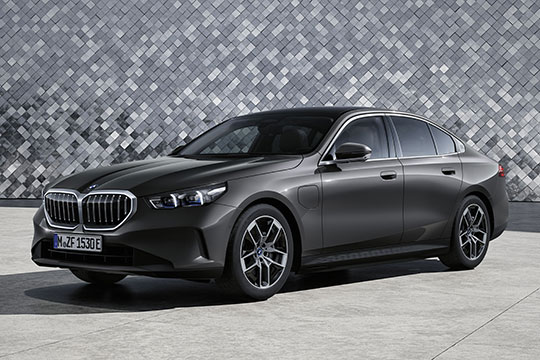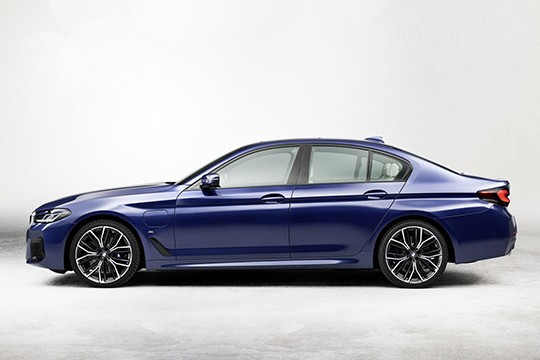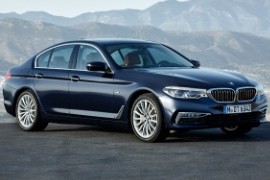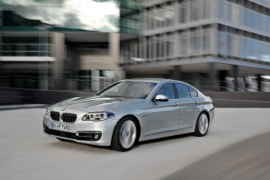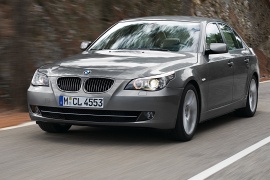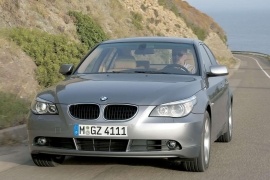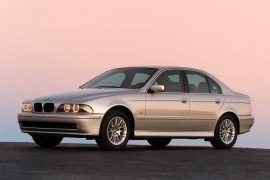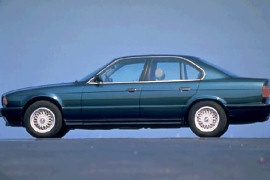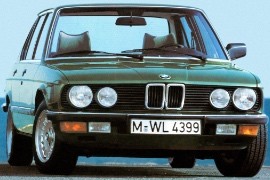BMW 5 Series Sedan Models/Series Timeline, Specifications & Photos
First production year: 1972
Engines: Mild hybrid diesel, Mild hybrid, Plug-in hybrid, Hybrid, Gasoline, Diesel, Hybrid gasoline
Following the seven generations of the 5 Series released by BMW from 1972 until now, the German automaker presents the new 2024 BMW 5 Series as a premium vehicle destined to bring the pleasure of driving to people worldwide.
The car has a full range of propulsion systems as it will come with a gasolineor diesel engines, a mild hybrid powertrain, or a fully electric version in the form of the BMW i5. The models can be equipped with an 8-speed automatic Steptronic Sport transmission capable of smoothly shifting through the gears to produce a distinguished feeling when accelerating.
By having an almost perfect 50:50 axle weight distribution, the 5 Series is capable of impressive dynamic performances, whether it comes in the all-wheel drive xDrive version or not.
The front view of the BMW represents a modern interpretation of the classic headlights separated by the established bean-shaped grille, which has an optional feature of coming with a BMW Iconic Glow contour lighting.
Two L-shaped taillights that are divided but simultaneously highlighted by a chrome stripe define the back of the new 5 Series. With a familiar side-view based on the previous model, the new model offers a look that enhances its dynamic character with the optional M Sport Package and the M Sport Package Pro.
While highly technologized, the new BMW 5 Series Sedan is the brand's first model to feature a fully vegan interior as standard.
By consistently digitalizing functions, the new BMW 5 Series cockpit has a considerably reduced quantity of buttons and controls in comparison to its predecessor. The BMW Curved Display makes the driving experience more effortless, as it is centered around the driver.
The redesigned steering wheel features a flattened lower section to ease the maneuvering of the BMW. Also, an impressive highlight is the optional BMW Interaction Bar, which spans the entire width of the instrument panel and extends into the door panels.
Besides the standard Parking Assistant and Reversing Assist, the vehicle can optionally have a Parking Assistant Professional feature that can provide automated parking and remote maneuvering from the mobile app.
Although, the real innovation comes with Highway Assistant, a technology that includes the world's first Active Lane Change Assistant with eye confirmation. The Highway Assistant, available only in Canada, Germany, and the USA, enables the driver to take his hands off the steering wheel at speeds up to 85 mph and relax while keeping his eyes on the road.
The Active Lane Change feature helps the driver-vehicle interaction reach a new level. The vehicle now offers lane change suggestions, which can be confirmed by looking in the exterior mirror before executing the lane change, a first-time capability implemented by BMW's engineers.
BMW introduced the seventh sequel of the 5 Series saga in late 2016, with deliveries starting in 2017, and four years later, in 2020, it refreshed it.
Known as the G30, the seventh generation of the 5 Series sedan was a significant step forward for those looking for a mid-size executive vehicle. While it was sharing most of its technologies and features with the brand’s flagship model, the 7 Series, it was also more affordable. Furthermore, it was sold with inline-four, fuel-efficient engines, which were unavailable for the car’s longer and pricier brother. Then, the 2020 model year came with additional upgrades that made it look even better and more appealing.
BMW didn’t want to call its refreshed vehicles “facelifted” but with a “Life Cycle Impulse.” It did that because sometimes the newer versions sported such small upgrades that some would need a keen eye for detail to spot the differences. In the G30 case, it was not. Its new LED headlights were slimmer and sported different daytime running lights. As an option, customers could fit them with the laser technology, which added L-shaped DRLs. The car’s kidney grille was available with black slats and chromed or dark surroundings. At the same time, depending on the trims and options, the lower bumper sported either a slimmer or a fatter apron with slim LED fog lamps.
From its profile, there were no significant changes, albeit since the front bumper was fatter, the car’s overall length had increased by 27 millimeters (1.1 inches). However, the wheelbase remained the same, and it didn’t need to be any longer than that. On the other hand, the details were subtle, such as the side fake vents on the front doors, which were either chromed or dark, depending on the options. Out back, the automaker installed new OLED taillights that made the car look wider. BMW also provided the vehicle with an M-Package, which included a different, sportier-looking rear bumper than the standard one.
Inside, the automaker slightly updated the interior. Atop the center stack was a 10.2-inch touchscreen for the iDrive infotainment system. A 12.3-inch display was available for the optional BMW Live Cockpit Professional. The automaker provided the car with a few options for the front seats, either covered in fabric, Alcantara, or suede. In the back, the 40/20/40 split-folding bench seat was available as an option. There were also various options for the sound system and the number of USB ports fitted inside the vehicle. Four-seat heating with front ventilation was also provided.
Under the hood, the automaker offered a wide choice of engines, depending on the market. The base model was the 520i, which sent 184 PS (181 hp) to the rear wheels via an eight-speed automatic. In Europe and other countries, BMW also sold the vehicle with a fuel-efficient inline-four 2.0-liter turbodiesel. Mild-hybrid and plug-in hybrid versions were also available, and so were the all-wheel drive (the xDrive) versions for most versions. Furthermore, the rear-wheel steering was on the options list, next to the adaptive dampers. As a result, the 5 Series could easily replace the base models of a 7 Series, but at a lower cost.
After seven years on the market, the sixth generation of the 5 Series, the F10, had to be retired, and BMW replaced it with the G30, a model that looked like an evolution rather than a revolution.
The seventh generation of the 5 Series was unveiled by the German automaker in late 2016, with sales and deliveries starting in 2017. Even though its overall appearance looked like a heavily facelifted F10, it was actually a new vehicle from the ground up. Firstly, it used the CLAR platform, carried over from the brand’s flagship model, the 7 Series. Apart from a few engines and gearboxes, the G30 inherited nothing from its predecessor. Everything was redesigned and imagined to push the 5 Series into a higher territory. It was more elegant, had better standard features, and provided a more refined driving experience than the sixth generation of the 5 Series.
At the front, the 5 Series received standard LED headlights, leaving customers with the option for Adaptive LEDs if they craved something more. Thanks to these, the vehicle could light up to 500 meters (1640 feet) without dazzling drivers in the oncoming traffic. Depending on the options, the front bumper featured slim lower air intakes or taller ones for vehicles fitted with the M-Packet.
The car’s profile revealed the long wheelbase of the vehicle, complemented by short overhangs on both ends. An oblique fake exhaust adorned the front doors, making the elegant vehicle look sportier. BMW offered it with body-colored door handles and mirrors but with an option for chromed elements that adorned them. The low-slung greenhouse with the sloped-down rear window helped the car get an excellent drag coefficient between 0.23 and 0.26, depending on trims and options. Out back, the broad taillights extended from the quarter panels to the trunk lid made the car look wider, while the lower bumper could also be optioned with the M-Package that made it more aggressive. Most versions featured side exhausts, one on each side, emphasizing the sporty image of the G30.
Inside, the low-mounted dashboard sported the free-floating-looking display of the iDrive infotainment system placed atop the center stack. At the same time, the driver fronted an instrument cluster that was available either with analog dials or with a completely digital panel. The automaker designed the cabin with horizontal lines that amplified the cabin’s width, and it was large enough. At the front, there were three seat options and several other upholstery configurations. It started with fabric and ended up with a Merino leather (man-made) that was smooth and comfortable. In the back, the split-folding (40/60) bench seat could accommodate up to three passengers. However, the transmission tunnel obstructed legroom for the one seated in the middle.
Under the hood, BMW offered the 2017 5 Series G30 with a wide choice of engines, either gasoline or turbodiesel, depending on the market. Most versions were paired with an eight-speed automatic gearbox. At the same time, while some were available with rear- or all-wheel drive systems, others were exclusively provided with the xDrive systems that sent the power in all corners.
BMW refreshed the sixth generation of the 5 Series, the F10, in 2013, four years after the model’s introduction in October 2009, but the changes were not over yet.
The German automaker sold more than 5.5 million units of the 5 Series ever since the model’s introduction in 1972, and customers were very happy with the F10. But still, BMW had its calendar of upgrades, so it applied them to the model in 2013. There were several exterior changes and other interior upgrades, but those were just the beginning. The final touch came later, in 2014 when a new family of engines came to refresh the powertrains of BMW’s mid-size executive sedan series.
In terms of design, the 5 Series F10 was loved by everyone, so the styling department had the difficult job of subtly improving it without spoiling it. As a result, the front fascia remained largely the same, although the headlights got standard bi-Xenon brights with an option for LED fog lamps. The door mirrors also sported LED blinkers.
From its profile, the athletic silhouette of the vehicle remained unaltered but was enhanced with new options for 18” alloy wheels. In the back, depending on the drivetrain version, the 5 Series featured either twin pipes on the side or two exhausts on each side.
The most significant changes happened on the inside, and especially on the dashboard. BMW installed a standard analog instrument cluster fitted with a lower LCD for additional information or a 10.25” TFT screen. Besides, atop the center stack, the car manufacturer introduced a new generation of infotainment systems named NBT (Next Best Thing).
Thanks to this new system, drivers could access the BMW ConnectedDrive system, which allowed them to book hotels in advance, avoid traffic congestion, or listen to online radios. Depending on the region, BMW offered even Facebook and Twitter integration into the system.
In terms of safety, thermal imaging, adaptive cruise control, automatic emergency braking, and Lane Departure Warning were also available as options. Furthermore, the 5 Series could also be fitted with an advanced automatic parking system, where the driver didn’t have to do anything, just to be seated behind the steering wheel.
Under the hood, the most significant novelty was the introduction of a new 143 PS (141 hp) version of the two-liter turbo diesel engine that was already installed on the 520d and the 525d. But that was just the beginning. In 2014, the refreshed version of the 5 Series F10 got rid of the old N-series engines (both gasoline and turbo diesel) and got the B-Series ones, which also came with improved fuel efficiency and lower emissions.
Like the non-facelifted version, the 5 Series F10 LCI was available with either six-speed manuals or eight-speed automatics that sent the torque to the rear or in all corners.
BMW 5 Series (F10) LCI 518d 6MT RWD (143 HP)
BMW 5 Series (F10) LCI 518d 6MT RWD (150 HP)
BMW 5 Series (F10) LCI 518d 8AT RWD (143 HP)
BMW 5 Series (F10) LCI 518d 8AT RWD (150 HP)
BMW 5 Series (F10) LCI 520d 6MT RWD (184 HP)
BMW 5 Series (F10) LCI 520d 6MT RWD (190 HP)
BMW 5 Series (F10) LCI 520d 8AT RWD (184 HP)
BMW 5 Series (F10) LCI 520d 8AT RWD (190 HP)
BMW 5 Series (F10) LCI 520d EfficientDynamics 6MT RWD (184 HP)
BMW 5 Series (F10) LCI 520d xDrive 8AT AWD (190 HP)
BMW 5 Series (F10) LCI 525d 6MT RWD (218 HP)
BMW 5 Series (F10) LCI 525d 8AT (218 HP)
BMW 5 Series (F10) LCI 525d xDrive 8AT (218 HP)
BMW 5 Series (F10) LCI 530d 6MT RWD (258 HP)
BMW 5 Series (F10) LCI 530d 8AT RWD (258 HP)
BMW 5 Series (F10) LCI 530d xDrive 8AT AWD (258 HP)
BMW 5 Series (F10) LCI 535d 8AT RWD (313 HP)
BMW 5 Series (F10) LCI 520i 6MT RWD (184 HP)
BMW 5 Series (F10) LCI 520i 8AT RWD (184 HP)
BMW 5 Series (F10) LCI 528i 6MT RWD (245 HP)
BMW 5 Series (F10) LCI 528i 8AT RWD (245 HP)
BMW 5 Series (F10) LCI 528i xDrive 8AT AWD (245 HP)
BMW 5 Series (F10) LCI 535i 6MT RWD (306 HP)
BMW 5 Series (F10) LCI 535i 8AT RWD (306 HP)
BMW 5 Series (F10) LCI 535i xDrive 8AT AWD (306 HP)
In late 2009, BMW launched the sixth generation of its 5 Series sedan, the F10, on the German market, followed by other countries in 2010, and changes above its predecessor were massive.
In 2006, Jacek Fröhlich penned the final shapes of the seventh generation of the 5 Series while the American Chris Bangle was still leading the automaker’s styling department. However, the new vehicle was considered miles ahead of its predecessor, the polarizing 5 Series E60. BMW didn’t want to risk being blamed for a too-bold design. It also created the new generation of this nameplate on the same CLAR platform used by the carmaker’s flagship, the 7 Series. And the end result was highly appreciated. But Chris Bangle was already on its way out when the car was revealed to the press.
With its smooth, swept-back headlights, the 2009 5 Series tried to look sportier. Between them, integrated into the bumper’s upper area, BMW placed its famous kidney grille with vertical slats adorned by a chromed rim. Lower, on the bumper, the car manufacturer placed an apron that sported a broad air intake that helped to cool the engine. The available fog lamps were installed on the outer side, sporting a triangular shape.
From its profile, the low-slung greenhouse, the long wheelbase, and the smooth sculptured lines from the door panels made the 2009 5 Series look elegant. Furthermore, the car was available with a long wheelbase for specific markets and sold as a luxury sedan. BMW installed standard 17-inch alloy wheels on the seventh generation of the 5 Series. However, customers could get an 18- or a 19-inch set, depending on the engine version. Out back, the elegant vehicle sported twin pipes.
Inside, the automaker created an elegant cabin. All versions were fitted with an infotainment system neatly integrated into the dashboard atop the center stack. Between the front seats on the center console, BMW installed the gear selector or the manual transmission gear stick, depending on the options. All versions featured a few specific buttons that controlled drive modes between Economic, Normal, and Sport. Fronting the driver was an analog dashboard with an integrated LCD at its bottom, showing data from the car’s onboard computer. At the same time, atop the center stack, BMW installed a small-sized, 4:3 aspect ratio screen for the infotainment system or a wider, 19:6 one. In the back, there was plenty of room for two adult-sized passengers, with enough legroom for a middle-seated one.
Under the hood, BMW introduced the F10 5 Series with a wide choice of engines, both gasoline and turbodiesel. Depending on the version, a six-speed manual was the first choice. An eight-speed automatic provided by ZF was available, regardless of the powerplant version. All the oomph went to the rear wheels, with available all-wheel drive versions.
BMW 5 Series (F10) 520d 6MT RWD (184 HP)
BMW 5 Series (F10) 520d 8AT RWD (184 HP)
BMW 5 Series (F10) 520d EfficientDynamics 6MT RWD (184 HP)
BMW 5 Series (F10) 520d Special Edition 6MT RWD (163 HP)
BMW 5 Series (F10) 525d 6MT RWD (204 HP)
BMW 5 Series (F10) 525d 6MT RWD (218 HP)
BMW 5 Series (F10) 525d 8AT RWD (204 HP)
BMW 5 Series (F10) 525d 8AT RWD (218 HP)
BMW 5 Series (F10) 525d xDrive 8AT AWD (218 HP)
BMW 5 Series (F10) 530d 6MT RWD (245 HP)
BMW 5 Series (F10) 530d 6MT RWD (258 HP)
BMW 5 Series (F10) 530d 8AT RWD (245 HP)
BMW 5 Series (F10) 530d 8AT RWD (258 HP)
BMW 5 Series (F10) 530d xDrive 8AT AWD (258 HP)
BMW 5 Series (F10) 535d 8AT RWD (300 HP)
BMW 5 Series (F10) 520i 6MT RWD (184 HP)
BMW 5 Series (F10) 520i 8AT RWD (184 HP)
BMW 5 Series (F10) 523i 6MT RWD (204 HP)
BMW 5 Series (F10) 523i 8AT RWD (204 HP)
BMW 5 Series (F10) 528i 6MT RWD (245 HP)
BMW 5 Series (F10) 528i 6MT RWD (258 HP)
BMW 5 Series (F10) 528i 8AT RWD (245 HP)
BMW 5 Series (F10) 528i 8AT RWD (258 HP)
BMW 5 Series (F10) 528i xDrive 8AT AWD (245 HP)
BMW 5 Series (F10) 530i 6MT RWD (272 HP)
BMW 5 Series (F10) 530i 8AT RWD (272 HP)
BMW 5 Series (F10) 535i 6MT RWD (306 HP)
BMW 5 Series (F10) 535i 8AT RWD (306 HP)
BMW 5 Series (F10) 535i xDrive 8AT AWD (306 HP)
BMW refreshed the 5 Series (E60) in 2007, and customers hoped that the facelifted version would fix the unusual lines adopted by the original version, but that didn’t happen.
Chris Bangle was still at the helm of BMW’s styling department in 2007, and he had to follow strict procedures regarding the look of the E60. As a result, the LCI version looked almost identical to the 2003 model year of the 5 Series. However, the engineering department burned the midnight oil to provide customers with more features and amenities to attract them. In the end, it was a better vehicle from the inside, with just minor exterior styling updates. But there was one little secret about the car’s appearance. Even though Chris Bangle led the design department, he wasn’t the person who penned it. The original sketches were drawn by the Italian stylist Davide Arcangeli, who unfortunately passed away before the car’s original launch.
At the front, the automaker introduced new headlights with clear lenses and Xenon brights. Furthermore, the lenses for the turn signal lamps were white instead of light-amber as on the previous model, which gave the vehicle a nicer front stance. Another improvement was for the lower part of the bumper, which received a chicken-wire-styled mesh for the air intake, and the center-mounted upside-down trapezoidal shape that adorned the 2003 model year was removed.
From its profile, there were no changes apart from new alloy wheel options and colors. Even the clear-lens turn signals from the front fenders were left in place with the same shape. It looked like the styling department was paid with lunch money.
Inside, the automaker improved the materials and introduced new upholsteries. But still, the double-bubble dashboard design was kept in place. A significant upgrade was made for the iDrive infotainment unit, which received new functions and a new styling. The most significant update was for the six-speed automatic gearbox lever. It looked like the one installed on the 2005 X5, with a shape that resembled the one of a golf club. That design idea was carried over the following two generations of the 5 Series. It was that good. Regarding interior technology, the color head-up display and the adaptive steering were part of the package that helped the vehicle sell in good enough numbers, although not as good as its predecessor, the E39.
Under the hood, BMW refreshed almost the entire engine lineup. It introduced new powerplants with intake and exhaust variable valve timing that improved fuel efficiency. Moreover, the automaker had to prepare the car for the upcoming 2009 Euro 5 emission standards. For that, it replaced the former M-family engines with the N-family ones, and that included both the gasoline and the turbodiesel powerplants.
BMW 5 Series (E60) 520d 6AT RWD (177 HP)
BMW 5 Series (E60) 520d 6MT RWD (177 HP)
BMW 5 Series (E60) 520d Special Edition 6AT RWD (163 HP)
BMW 5 Series (E60) 520d Special Edition 6MT RWD (163 HP)
BMW 5 Series (E60) 525d 6AT RWD (197 HP)
BMW 5 Series (E60) 525d 6MT RWD (197 HP)
BMW 5 Series (E60) 525d xDrive 6AT AWD (197 HP)
BMW 5 Series (E60) 525d xDrive 6MT AWD (197 HP)
BMW 5 Series (E60) 530d 6AT RWD (235 HP)
BMW 5 Series (E60) 530d 6MT RWD (235 HP)
BMW 5 Series (E60) 530d xDrive 6AT AWD (235 HP)
BMW 5 Series (E60) 520i 6AT RWD (170 HP)
BMW 5 Series (E60) 520i 6MT RWD (170 HP)
BMW 5 Series (E60) 523i 6AT RWD (190 HP)
BMW 5 Series (E60) 523i 6MT RWD (190 HP)
BMW 5 Series (E60) 525i 6AT RWD (218 HP)
BMW 5 Series (E60) 525i 6MT RWD (218 HP)
BMW 5 Series (E60) 525i xDrive 6AT AWD (218 HP)
BMW 5 Series (E60) 525i xDrive 6MT AWD (218 HP)
BMW 5 Series (E60) 528i xDrive 6AT AWD (230 HP)
BMW 5 Series (E60) 528i xDrive 6MT AWD (230 HP)
BMW 5 Series (E60) 530i 6AT RWD (272 HP)
BMW 5 Series (E60) 530i 6MT RWD (272 HP)
BMW 5 Series (E60) 530i xDrive 6AT AWD (272 HP)
BMW 5 Series (E60) 530i xDrive 6MT AWD (272 HP)
BMW 5 Series (E60) 535i xDrive 6AT AWD (306 HP)
BMW 5 Series (E60) 535i xDrive 6MT AWD (306 HP)
BMW 5 Series (E60) 540i 6AT RWD (306 HP)
BMW 5 Series (E60) 540i 6MT RWD (306 HP)
BMW introduced the fifth generation of the 5 Series in the summer of 2003, and customers were shocked by the car’s look, but not in a good way.
In the early ‘90s, BMW hired the American designer Chris Bangle to reshape the entire automaker’s lineup design language. At first, there were a few products that were highly appreciated. But then, the automaker launched the 7 Series (E65) and the 5 Series (E60) products that were not on top of the carmaker’s fans list. The “flame surfacing” design idea imagined by the artist was not everybody’s cup of tea, and the fifth generation of the 5 Series was the one that triggered more negative reactions, especially since it came after the E39, which was praised for its look. All these led to slower sales for the E60, which made BMW’s shareholders angry. In its seven-year production run, the E60 (in both sedan and station wagon shapes) was outsold by its predecessor by over 100,000 units. But, thanks to its advanced technologies, the car was praised for its comfortable ride, butter-smooth engines, and high-quality interiors.
At the front, the swept-back headlights were far ahead of its times. They looked like wings that flanked the slanted BMW’s kidney grille with vertical slats. This was integrated into the bumper instead of being part of the hood, which was another unusual decision, even though it was correct. Lower, the bumper featured a broad grille that integrated the available fog lamps and an upside-down trapezoidal air intake.
From its profile, the smooth and curved lines of the bodywork were shockingly disrupted by the lines of the trunk. A diagonal cut emerged from the C-posts, visually connecting them to the rear bumper. In addition, the oversized rear overhang made the vehicle look too heavy, even though it was not. Furthermore, the triangular taillights flanked the rear fascia and limited the trunk opening. As a result, even though there was room for four golf bags in the luggage area, it took a lot of work to fit them there.
Inside, there were more controversies about the double-bubble dashboard design. BMW installed two clusters on the dash: one for the instrument panel fronting the driver and another one for the 6.5” infotainment screen atop the center stack. Between the front bucket seats, the automaker placed the rotary dial of the iDrive’s infotainment system, which was easy to control without having to look at it. That was a plus in terms of ergonomics but not in terms of aesthetics. In the back, there was plenty of room for three full-size adults. Furthermore, the center tunnel was slim enough to not significantly limit legroom for the middle-seated passenger.
Under its skin, the E60 5 Series opened a new chapter in the carmaker’s history. It was the first to be available with more versions of all-wheel drive versions. Thanks to the aluminum components used to build the vehicle, the 5 Series felt light on its feet. Furthermore, the car could be fitted with active steering and adaptive headlights, which greatly improved maneuverability.
BMW 5 Series (E60) 520d 6AT RWD (163 HP)
BMW 5 Series (E60) 520d 6MT RWD (163 HP)
BMW 5 Series (E60) 525d 6AT RWD (177 HP)
BMW 5 Series (E60) 525d 6MT RWD (177 HP)
BMW 5 Series (E60) 530d 6AT RWD (218 HP)
BMW 5 Series (E60) 530d 6AT RWD (231 HP)
BMW 5 Series (E60) 530d 6MT RWD (218 HP)
BMW 5 Series (E60) 530d 6MT RWD (231 HP)
BMW 5 Series (E60) 530xd 6AT RWD (231 HP)
BMW 5 Series (E60) 520i 5AT RWD (170 HP)
BMW 5 Series (E60) 520i 6MT RWD (170 HP)
BMW 5 Series (E60) 523i 5AT RWD (177 HP)
BMW 5 Series (E60) 523i 6MT RWD (177 HP)
BMW 5 Series (E60) 525i 6AT RWD (192 HP)
BMW 5 Series (E60) 525i 6AT RWD (218 HP)
BMW 5 Series (E60) 525i 6MT RWD (192 HP)
BMW 5 Series (E60) 525i 6MT RWD (218 HP)
BMW 5 Series (E60) 525xi 6AT RWD (218 HP)
BMW 5 Series (E60) 525xi 6MT RWD (218 HP)
BMW 5 Series (E60) 530i 6AT RWD (231 HP)
BMW 5 Series (E60) 530i 6AT RWD (258 HP)
BMW 5 Series (E60) 530i 6MT RWD (231 HP)
BMW 5 Series (E60) 530i 6MT RWD (258 HP)
BMW 5 Series (E60) 530xi 6AT RWD (258 HP)
BMW 5 Series (E60) 530xi 6MT RWD (258 HP)
BMW 5 Series (E60) 540i V8 6AT RWD (306 HP)
BMW 5 Series (E60) 540i V8 6MT RWD (306 HP)
BMW 5 Series (E60) 545i V8 6AT RWD (333 HP)
BMW 5 Series (E60) 545i V8 6MT RWD (333 HP)
BMW introduced a facelifted version for the fourth generation of the 5 Series in late 2000 for the 2001 model year, and besides some exterior changes, it also featured engine upgrades.
By 2000, the 5 Series was already one of the best-selling premium sedans in the world. Its wide engine range, features, and comfort were on par with or above its competitors. While it lacked an all-wheel drive version, such as those provided by Audi or Mercedes-Benz for their A6 and the E-Class, respectively, it featured advanced engineering solutions. Thanks to the styling updates made by BMW for the 2001 model year, the E39 looked young again and eager to satisfy its owners. The LCI (Life Cycle Impulse), as it was known in BMW’s naming system, also marked a crucial step in the automaker’s evolution strategy since it was the first 5 Series generation to be sold in more than 1.5 million units, sedan and Touring versions combined.
At the front, the most significant change was for its headlights. While these still featured a dual-headlamp styling, they had circular daytime running lights inside them, gaining the nickname of “angel eyes.” In addition, the automaker installed clear corner-mounted turn signals instead of those from the non-facelifted version that sported orange lenses. Furthermore, on the lower bumper, the automaker installed a thick and wide air intake and an apron that improved aerodynamics. Like its non-facelifted sibling, the E39 LCI (Life Cycle Impulse) boasted an excellent drag coefficient of just 0.27.
From its profile, the automaker replaced the black rubber stripe that crossed the vehicle from front to back with a body-colored one. As a result, the car’s shape looked smoother. The pulled-out side sills made the air current avoid the rear wheel arches, improving airflow. Thanks to the curved roofline, imagined by the Japanese designer Joji Nagashima, the E39 retained the main core values of the German automaker. It even sported the famous Hofmeister kink behind the rear doors. Finally, the 2001 5 Series received a new set of taillights at the back, with white areas for the reversing lights and turn signals.
Inside, the 2001 E39 was available in a few options that ranged from cloth upholstery and plastic trims to woodgrain on the dash and leather seats. Furthermore, an extended leather pack also covered the center console. The driver fronted a new steering wheel with buttons that controlled the stereo. In addition, customers could order the vehicle with an M-Sport package that added a three-spoke steering wheel. On the center stack, the automaker added a new display for the infotainment system with a 19:6 ratio instead of the 4:3 one used on the non-facelifted version.
Under the hood, BMW revamped the entire engine lineup, preparing them for the new Euro 3 emission standards that came into force starting on January 1st, 2001. Besides the gasoline engines, the automaker also offered a few choices of diesel units. Most versions were paired with five-speed manuals or automatics, while some engine versions were available with a six-speed manual for selected markets.
In December 1995, BMW introduced the fourth generation of the 5 Series, also known as the E39, and it was a revolutionary model in the nameplate's history since it came with significant improvements in all areas.
The 5 Series was already a sought-after vehicle on the market. Unlike other premium sedans, it provided a sporty feeling. It was the regular sports sedan for executives, but it could also be a quiet and refined companion while doing school runs. Unlike its predecessors, the new model featured all-aluminum links for the suspension that reduced the car's overall weight. Furthermore, BMW introduced new, lightweight engines that made the 5 Series feel light on its feet, even though it was a large vehicle for those times' standards. However, unlike its predecessor, the E39 wasn't offered with an all-wheel drive system.
One of the most significant changes in the model's history was that it didn't have four headlights at the front anymore. It featured dual headlamps on each side but was covered under the same piece of glass and sported the turn signals on the outer area. The bumper was aerodynamically profiled, contributing to the 0.27 drag coefficient of the E39.
Unlike its predecessors, the E39 featured a rounded-shaped greenhouse. The car appeared during the height of the bio-design era. The Japanese designer Joji Nagashima penned it in 1992, and the flowing lines of the bodywork matched the market's trend. It was far ahead of its main competitors. Furthermore, the body-colored flush door handles and mirrors amplified the smooth overall look of the car. On the lower side, the E39 featured pulled-out side sills, thus protecting the rear wheels from wind current. Finally, at the back, the automaker installed an extended skirt under the bumper, and the exhausts peaked from underneath it.
The interior was another revolution in terms of space and features. Customers could get the vehicle with a multifunction steering wheel. BMW installed buttons that controlled the audio and other functions of the car. The bolstered front seats provided adequate side support for high-speed cornering. Fronting the driver was a rounded-shaped instrument cluster filled with the usual four-dial system introduced by the automaker on the first generation of the 5 Series. Furthermore, an LCD placed at the bottom of the instrument panel showed additional data from the onboard computer. On the center stack, the automaker installed an integrated stereo. Wood trims and leather upholstery were part of a premium package that made the customers feel pampered. In the back, the bench seat could accommodate up to three passengers, although the legroom for the middle-seated one was limited due to the tall transmission tunnel.
Under the hood, the E39 offered only 100 hp+ engines, with four or six cylinders. Besides the mighty M5, there were also other two V8 options. Power went to the rear wheels only via either a five-speed manual or a four- or five-speed automatic, depending on the engine version. BMW also introduced a wider range of turbodiesel powerplants.
BMW 5 Series (E39) 520d 5MT RWD (136 HP)
BMW 5 Series (E39) 525d 4AT RWD (163 HP)
BMW 5 Series (E39) 525d 5MT RWD (163 HP)
BMW 5 Series (E39) 525td 5MT RWD (115 HP)
BMW 5 Series (E39) 525tds 5AT RWD (143 HP)
BMW 5 Series (E39) 525tds 5MT RWD (143 HP)
BMW unveiled the third generation of the 5 Series, the E34, in December 1987, less than eight years after the introduction of the car’s second generation in 1981.
The Italian designer Ercole Spada made the first sketches for the third generation of the 5 Series in 1982, just a year after the car’s second generation was released. BMW didn’t want to play it safe this time with a mild evolution. As a result, it started from a blank sheet of paper, and the new model was far more advanced in every way. It was longer, more comfortable, and fitted with more powerful engines. Furthermore, it was the first 5 Series to be equipped with an all-wheel-drive system and the first to be available as a station wagon starting in 1992. In addition, the German automaker developed not just one but two M5 versions based on the E34.
While the front fascia still featured the design signature of a four-headlight styling, that was the only visual connection with the E28 and the E12, respectively. Its main grille, crossed by thin horizontal slats, was interrupted in the middle by BMW’s specific kidney-grille design element. Furthermore, the bumper was extended downwards with an apron and could be fitted with rectangular fog lamps.
Unlike its predecessors, which were penned in a boxy styling, the 1988 5 Series boasted curved lines that improved the vehicle’s aerodynamics. The ascending beltline and the raked and curved windshield also helped lower the drag coefficient. A rubber stripe crossed the vehicle front to back, visually connecting the front and rear bumpers. To further enhance the premium look of the 5 Series, BMW introduced body-colored door handles and mirrors. In addition, most versions featured standard alloy wheels. At the back, the 5 Series featured narrower taillights than its predecessor. Unlike that model, this one had them split between the rear quarter panels and the trunk’s lid.
Inside, the idea of the center stack tilted towards the driver was carried over from the E28. There, BMW installed the HVAC controller, the stereo, and the available onboard computer display. That could show the driver various data such as remaining range, average fuel consumption, average speed, and service intervals. Fronting the driver was a trapezoidal-shaped instrument cluster integrated into the dashboard, showing the classic BMW layout, with large dials for the speedometer and tachometer and smaller gauges for the fuel level and the coolant temperature. The bolstered front seats could keep their occupants during high-speed cornering maneuvers. In the back, the automaker installed a bench seat for three passengers.
Under its skin, the E34 marked several new improvements. It was the first to boast two versions for the M5 and the first available with adaptive dampers. The engine range started with a mundane 1.8-liter inline-four powerplant, which was available until 1996, while the top version, non-M, was the 540i fitted with a 5.0-liter V8 unit. In addition, the automaker offered the car with a choice of turbodiesel engines. BMW also introduced adaptive dampers and the Automatic Stability Control + Traction (ASC+T), which limited the power sent to the wheels to prevent them from spinning.
BMW 5 Series (E34) 518i 4AT RWD (115 HP)
BMW 5 Series (E34) 518i 5MT RWD (115 HP)
BMW 5 Series (E34) 520i 4AT RWD (129 HP)
BMW 5 Series (E34) 520i 5AT RWD (150 HP)
BMW 5 Series (E34) 520i 5MT RWD (129 HP)
BMW 5 Series (E34) 520i 5MT RWD (150 HP)
BMW 5 Series (E34) 525i 4AT RWD (192 HP)
BMW 5 Series (E34) 525i 4AT RWD (170 HP)
BMW 5 Series (E34) 525i 5MT RWD (170 HP)
BMW 5 Series (E34) 525i 5MT RWD (192 HP)
BMW 5 Series (E34) 525ix 5AT RWD (192 HP)
BMW 5 Series (E34) 525ix 5MT RWD (192 HP)
BMW 5 Series (E34) 530i 4AT RWD (188 HP)
BMW 5 Series (E34) 530i 5AT RWD (218 HP)
BMW 5 Series (E34) 530i 5MT RWD (188 HP)
BMW 5 Series (E34) 530i 5MT RWD (218 HP)
BMW 5 Series (E34) 535i 4AT RWD (211 HP)
BMW 5 Series (E34) 535i 5MT RWD (211 HP)
Nine years after the model’s nameplate introduction, BMW was ready to release the second generation of the 5 Series, the E28, which surprised anyone with its advanced technologies for its era.
While the first generation of the 5 Series benefited from the magic hands of Marcello Gandini and Paul Bracq, its successor looked more like a slight evolution. But still, the car was completely new from the ground up, except for some engines that were carried over from the E12. However, the second generation of the 5 Series came with significant technical improvements. It was BMW’s first car to be powered by a turbodiesel engine and the first fitted with an antilock braking system, or ABS. Furthermore, the vehicle finally received an air conditioning unit, making driving more pleasant during hot summers. The car was also available with other luxury features, such as power windows and locks, a sunroof, and a stereo. BMW made the switch towards the premium segment, and it was winning. Last but not least, it was the generation that introduced the M5 version.
The 5 Series featured a front fascia with a recessed lower area, making it look like a shark nose. Its four-headlight styling resembled the 3, 6, and 7 Series. BMW also used a plastic bumper with chromed trims and rubber areas. For vehicles sold in the U.S., the German automaker made a different bumper, with thicker rubber elements, to comply with the five-mph (8 kph) crash-protection rule. In addition, a set of turn signals and parking lights were installed, and customers could order the vehicle with a set of rectangular fog lamps.
From its profile, the E28 featured flat surfaces and a creased line that crossed the car from headlights to taillights. Its flush door handles were black instead of chromed as on its predecessor, and depending on the grade and the engine version, it was available with black trims around the window line. The rear deck was horizontal, not sloped down, as the one from the E12, and that led to a bigger trunk space. Out back, the automaker installed wide and tall taillights to increase the visibility from behind.
Inside, the automaker created a revolutionary cabin for those times. The center stack was tilted towards the driver’s seat. It sported the controls for the audio and the HVAC system. Fronting the driver was an instrument cluster neatly integrated into the overall shape of the dashboard. It featured large dials for the tachometer and speedometer flanked by the fuel level and the temperature gauges. Furthermore, the automaker offered customers the option to equip the 5 Series with an inspection reminder consisting of a series of green, yellow, and red LEDs that warned the owners that they had to go for an oil flush. In the back, the comfortable bench seat had a retractable center armrest and provided enough legroom for three passengers.
Under the hood, the 5 Series was available right from the start, with four and six-cylinder engines and fuel injection. In 1986, BMW also added diesel engines for the 5 series, with or without a turbocharger. However, the most significant version of the car was the 1984 M5. At the time of its launch, the M5 was the fastest sedan in the world thanks to its M88/3 3.5-liter engine that developed 286 PS (282 hp). The Canadian and the U.S. versions were fitted with a detuned version of that engine that provided 260 PS (256 hp).
BMW 5 Series (E28) 518 4MT RWD (90 HP)
BMW 5 Series (E28) 518 5MT RWD (90 HP)
BMW 5 Series (E28) 518i 5MT RWD (102 HP)
BMW 5 Series (E28) 520i 3AT RWD (125 HP)
BMW 5 Series (E28) 520i 4MT RWD (125 HP)
BMW 5 Series (E28) 520i 5MT RWD (125 HP)
BMW 5 Series (E28) 525e 4AT RWD (125 HP)
BMW 5 Series (E28) 525e 4AT RWD (129 HP)
BMW 5 Series (E28) 525e 5MT RWD (125 HP)
BMW 5 Series (E28) 525e 5MT RWD (129 HP)
BMW 5 Series (E28) 525i 3AT RWD (150 HP)
BMW 5 Series (E28) 525i 4MT RWD (150 HP)
BMW 5 Series (E28) 525i 5MT RWD (150 HP)
BMW 5 Series (E28) 528e 3AT RWD (122 HP)
BMW 5 Series (E28) 528e 5MT RWD (122 HP)
BMW 5 Series (E28) 528i 3AT RWD (184 HP)
BMW 5 Series (E28) 528i 5MT RWD (184 HP)
BMW unveiled the first generation of the 5 Series in 1972, and it was one of the most significant steps made by the German automaker to regain its status as a premium automaker.
After it ditched the bankruptcy bullet in the '50s, the German automaker started creating a new product line. As a result, in 1970, the automaker unveiled the Garmisch concept at the Geneva Motor Show, a two-door sedan that envisioned the first generation of the 5 Series, also known as the E12. In the same year, the company hired Paul Bracq as the Chief of Design. Marcello Gandini of Bertone helped him draw the exterior lines of the vehicle's production version. Furthermore, BMW used computers to simulate safety systems and create crumple zones. It was an advanced vehicle that used a new platform, and the result was a highly successful model that lasted until 1981 when BMW replaced it with the E28, the moniker's second generation.
The new model shook the audience when it was unveiled. It sported a four-headlights front fascia with a broad grille between them. In the middle, the automaker placed its well-known kidney grille with two vertical elements adorned by chromed trims. BMW also created a slim metallic bumper adorned by a black rubber trim. Below it, on the vehicle's apron, the automaker added an additional broad air intake that helped to cool the engine.
From its profile, the boxy-looking sedan sported a set of lines that stretched from the headlights to the taillights and between the front and rear wheel arches. Its raked windshield and tall cabin were designed to create an airy interior and provide excellent visibility for the driver. To make it look upscale, BMW installed chromed details on the flush door handles and around the windows. At the back, the raked-forward rear window and the sloped-down deck made the vehicle look sporty.
Inside, the German automaker installed a pair of bucket seats at the front and a bench seat for three in the back. The dashboard looked modern thanks to its center stack, while the rectangular-shaped instrument cluster in front of the driver. BMW placed large dials for the speedometer and tachometer in the middle, flanked by the fuel level and the temperature gauges. In the back, there was enough room for three passengers, albeit the tall transmission tunnel limited legroom for the middle-seated one.
Under the hood, BMW installed a choice of four or six-cylinder engines ranging between 90 PS (89 hp) and 184 PS (181 hp) until 1980. Then, in 1980, the German car manufacturer introduced the M535i, which featured a 3.5-liter powerplant with double-overhead camshafts and 24 valves that produced 218 PS (215 hp). All versions sent their power to the rear wheels via either a four- or five-speed manual gearbox or a three-speed automatic, depending on the engine.
BMW 5 Series (E12) 518 3AT RWD (90 HP)
BMW 5 Series (E12) 518 4MT RWD (90 HP)
BMW 5 Series (E12) 520 3AT RWD (115 HP)
BMW 5 Series (E12) 520 4MT RWD (115 HP)
BMW 5 Series (E12) 520i 3AT RWD (130 HP)
BMW 5 Series (E12) 520i 4MT RWD (130 HP)
BMW 5 Series (E12) 525 3AT RWD (145 HP)
BMW 5 Series (E12) 525 4MT RWD (145 HP)
BMW 5 Series (E12) 528 3AT RWD (165 HP)
BMW 5 Series (E12) 528 4MT RWD (165 HP)
BMW 5 Series (E12) 528i 3AT RWD (177 HP)
BMW 5 Series (E12) 528i 4MT RWD (177 HP)
